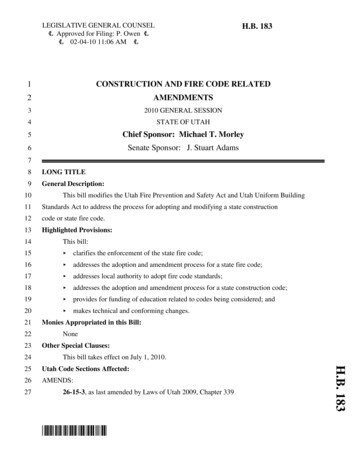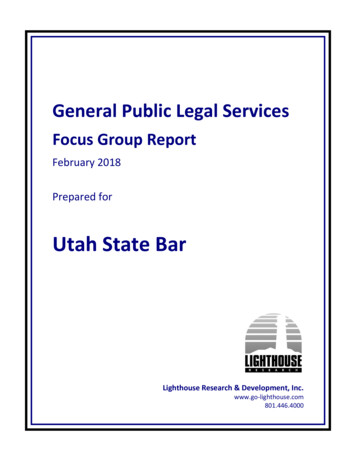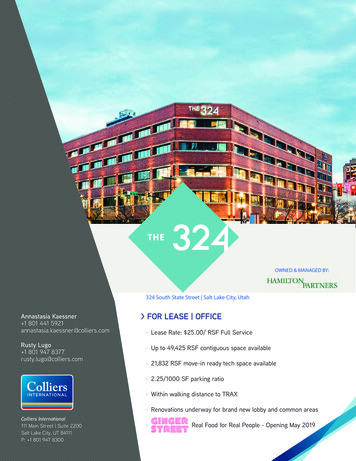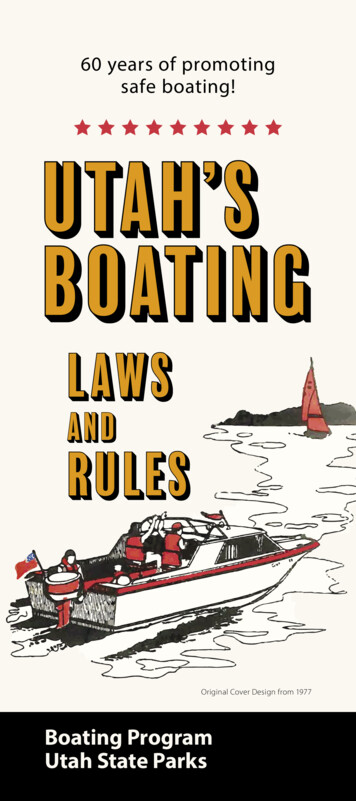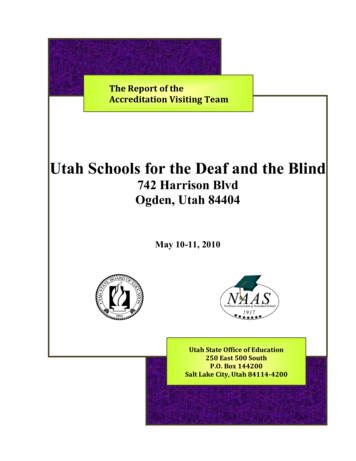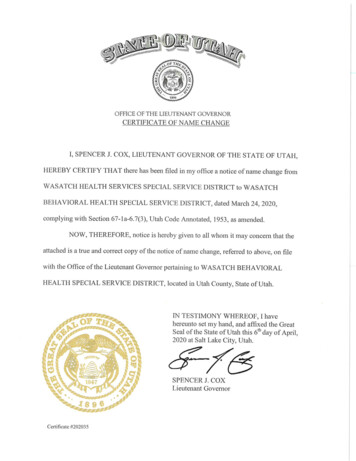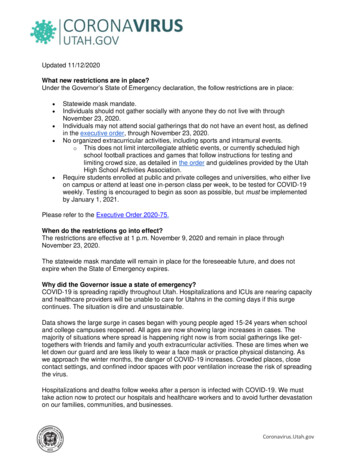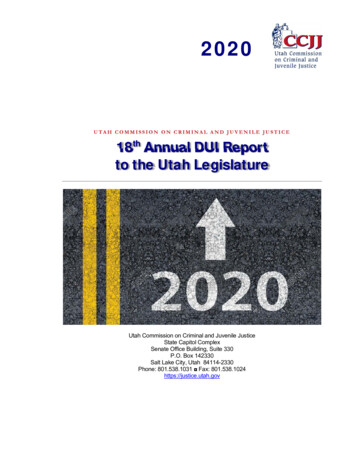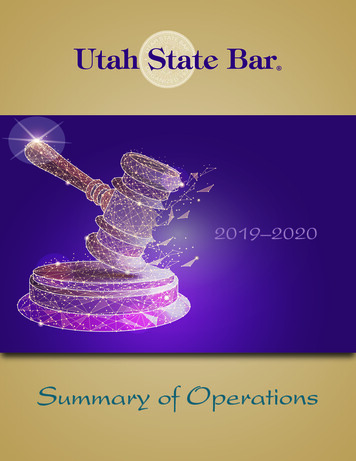
Transcription
Utah State Bar 2019–2020Summary of Operations
Vision of the Utah State BarA just legal system that is understood, valued, and accessible to all.Mission of the Utah State BarLawyers serving the public and legal professionwith excellence, civility, and integrity.Utah State Bar Statement onDiversity and InclusionThe Bar values engaging all persons fully, including persons of different ages,disabilities, economic status, ethnicities, genders, geographic regions,national origins, sexual orientations, practice settings and areas,races and religions. Inclusion is critical to the success of the Bar,the legal profession and the judicial system.The Bar shall strive to:Increase members’ awareness of implicit and explicit biases andtheir impact on people, the workplace, and the profession;Make Bar services and activities open, available, and accessible to all members;Support the efforts of all members in reaching their highest professional potential;Reach out to all members to welcome themto Bar activities, committees, and sections; andPromote a culture that values all members ofthe legal profession and the judicial system.2Summary of Utah State Bar Operations 2019–2020
Introduction and Grants of AuthorityThe Utah State Bar operates under authority granted by the Utah Supreme Court through orders which restatethe Court’s inherent authority under the Utah Constitution to regulate the practice of law. Those orders confirmthe specific purposes, duties and responsibilities of the Utah State Bar as:Advancing the administration of justice according to law;Aiding the courts in carrying on the administration of justice;Regulating the admission of persons seeking to practice law;Regulating and disciplining persons practicing law;Fostering and maintaining integrity, competence and public service among those practicing law;Representing the Bar before legislative, administrative and judicial bodies;Preventing the unauthorized practice of law;Promoting professionalism, competence and excellence in those practicing law throughcontinuing legal education and by other means;Providing service to the public, to the judicial system and to members of the Bar;Educating the public about the rule of law and their responsibilities under the law; andAssisting members of the Bar in improving the quality and efficiency of their practice.The Board of Bar Commissioners has been granted all powers necessary and proper to carry out the duties andresponsibilities of the Bar and the purposes of the Rules and has all authority not specifically reserved to the Court.The Bar’s internal operations are governed by By-laws and through the establishment of a variety of administrativepolicies and procedures. Other rules necessary to regulate and manage the practice of law havebeen promulgated by the Bar and approved by the Court and have been amended from time totime as needs have changed and demands have increased. These other rules include the RulesGoverning Admission, Rules of Lawyer Discipline and Disability, Rules of ProfessionalConduct, Rules for Lawyers’ Fund for Client Protection, the Law Student AssistanceRule and the Rules of the Utah State Bar Dispute Resolution Committee. The Court hasalso established rules governing mandatory continuing legal education. These rules may befound at www.utcourts.gov.Summary of Utah State Bar Operations 2019–20203
Bar LeadershipThe Bar is a 501(c)(6) non-profit Utah corporation governed by a fifteen-member Board of Bar Commissioners,which includes two court-appointed public members, twelve elected lawyers representing the judicial districts,and two elected officers. (Note: The President-elect may also serve as a Commissioner during his/her Presidentelect year.) The Commission also includes twelve non-voting ex officio members. The Commission hires anExecutive Director to carry out the operations of the Bar and the policies of the Commission. The ExecutiveDirector employs and supervises the activities of operations staff, which numbers twenty-six full-time and onepart-time employee.During the 2019–2020 year, the Bar Commission included the following:ELE CTED O F F I C E R SHerm Olsen, PresidentHillyard Anderson & Olsen – LoganHeather Farnsworth, President-elect3rd Division – Tooele, Salt Lake, and Summit CountiesMatch & Farnsworth – Salt Lake CityELE CTED L AW Y E R S A N D G E OGR AP HIC AR E AMarty Moore, 1st DivisionBox Elder, Cache, and Rich CountiesMayer Hoffman McCann, PC – LoganMichelle Quist, 3rd DivisionTooele, Salt Lake, and Summit CountiesKunzler Bean & Adamson – Salt Lake CityJohn W. Bradley, 2nd DivisionWeber, Morgan, and Davis CountiesAttorney General’s Office – OgdenThomas W. Seiler, 4th DivisionMillard, Juab, Utah, and Wasatch CountiesSeiler Anderson Fife & Marshall, LC – ProvoChrystal Mancuso-Smith, 3rd DivisionTooele, Salt Lake, and Summit CountiesSwenson & Shelley – Salt Lake CityCara M. Tangaro, 3rd DivisionTooele, Salt Lake, and Summit CountiesTangaro Law Firm – Salt Lake CityMark O. Morris, 3rd DivisionTooele, Salt Lake, and Summit CountiesSnell & Wilmer – Salt Lake CityHeather L. Thuet, 3rd DivisionTooele, Salt Lake, and Summit CountiesChristensen & Jensen – Salt Lake CityMark W. Pugsley, 3rd DivisionTooele, Salt Lake, and Summit CountiesRay Quinney & Nebeker – Salt Lake CityKristin “Katie” Woods, 5th DivisionWashington, Iron, Beaver, Sanpete, Sevier, Piute,Wayne, Garfield, and Kane CountiesAttorney at Law – St. GeorgePUBL I C M EM B E R S A P P O I N T E D B Y T HE S UP R E ME C OURTSteven R. Burt, AIAEntelen Design-Build – Salt Lake City4Summary of Utah State Bar Operations 2019–2020Mary Kay Griffin, CPACBIZ & Mayer Hoffman McCann, PC – Salt Lake City
EX O F F I CI O ME M B E R SH. Dickson Burton, ImmediatePast PresidentTrask Britt, PC – Salt Lake CityMargaret D. Plane, Utah ABAMembers’ DelegatePark City Corporation – Park CityElizabeth Kronk Warner, Dean,S. J. Quinney College of Law –Salt Lake CityNathan D. Alder, Utah State BarDelegate to the ABAChristensen & Jensen, PC –Salt Lake CityD. Gordon Smith, Dean,J. Reuben Clark School of Law– ProvoRobert O. Rice, Judicial CouncilRepresentativeRay Quinney & Nebeker –Salt Lake CityLarissa Lee, Utah Supreme CourtRepresentativeAdministrative Office of the Courts– Salt Lake CityErik A. Christiansen, Utah StateBar Delegate to the ABAParsons Behle & Latimer –Salt Lake CityCamila V. Moreno, YoungLawyers Delegate to the ABAUnited States District Court –Salt Lake CityKate Conyers, Women Lawyers ofUtah RepresentativeConyers & Nix – Salt Lake CityRemington “Jiro” Johnson,Minority Bar AssociationRepresentativeSalt Lake Legal Defenders –Salt Lake CityAmy Fowler, LGBT & AlliedLawyers of Utah RepresentativeFowler Venable Law, PC –Salt Lake CityVictoria “Tori” Finlinson,Young Lawyers DivisionRepresentativeClyde Snow & SessionsCandace Gleed, ParalegalDivision RepresentativeEisenberg Cutt Kendell & Olsen –Salt Lake CitySummary of Utah State Bar Operations 2019–20205
Licensing StatisticsSTATUS2018–20192019–2020 ChangeActive8,5888,705117Active under 3 years965893(72)Active Emeritus21323219In House Counsel1011141333—Licensed Paralegal Practitioner—44Military 15111112,91013,103193Foreign Legal CounselActive Attorneysby Region2018–20192019–2020 Change1st Division (Logan–Brigham)182192102nd Division (Davis–Weber)909936273rd Division (Salt Lake)5,6475,641(6)4th Division (Utah)1,2871,3031650551611Out of State1,3401,36424Total Active Attorneys9,8709,952825th Division (Southern Utah)ACTIVE ATTORNEYS BY DIVISION: 2019–2020Inactive Status AttorneysInactive – Full ServiceInactive – No ServiceInactive EmeritusInactive House CounselSubtotal – InactiveTotal Active & Inactive1st Division2nd Division3rd Division4th Division5th DivisionOut of StateBar Programs and ServicesRE GUL ATO RY S E RV I C E SSpecial AdmissionsSpecial admissions include reviewing and processing Military Lawyers, House Counsel, Admission on Motion andPro Hac Vice applications. During the Fiscal 2019–2020 year, we had the following special admissions HDRAWNMilitary1House Counsel29271000Motion26562231UBE Transfers12503131Pro Hac Vice301Summary of Utah State Bar Operations 2019–2020
AdmissionsAdmissions includes the application process, character and fitness file reviews and hearings, Bar exam questiondrafting and selection, preparation and administration, grading essay exams, and all reciprocal admissions.Committees include the Admissions Committee (Steven T. Waterman and Daniel A. Jensen, Co-chairs), Characterand Fitness Committee (Amy J. Oliver and Andrew M. Morse, Co-chairs), Bar Examiner Committee (Tanya N.Lewis and Mark Astling, Co-chairs), and the Test Accommodation Committee (Joan M. Andrews, Chair).JULY 2 0 1 9 BAR E X AMI NAT I O N S TAT I S T I C S228 Bar Examinees 187 Successful Bar Examinees Pass Rate for the July 2019 Bar Exam: 82%Essay ScoresMultistate Scores: 200 Points Possible50 Points PossibleUtah Average: 146.3Average Score: 30.6National Average: 141.1 (45,334 tested)Combined ScoresUtah Median Score: 292.4Passing Score: 270FE BRUARY 2020 B AR E X AMI NAT I O N S TAT I S T I C S79 Bar Examinees 49 Successful Bar Examinees Pass Rate for the February 2020 Bar Exam: 62%Essay ScoresMultistate Scores: 200 Points Possible50 Points PossibleUtah Average: 140.5Average Score: 30.2National Average: 132.6 (19,122 tested)Combined ScoresUtah Median Score: 280.8Passing Score: 270Professional Conduct EnforcementThe Office of Professional Conduct investigates complaints of unethical conduct; provides ethics educationseminars; and either resolves or prosecutes cases before hearing panels, the district courts and the Utah SupremeCourt. The administrative oversight of the Office of Professional Conduct is no longer under the Utah State Bar.That administrative oversight is now with an Oversight Committee (Judge Diana Hagen, Chair) that reportsdirectly to the Utah Supreme Court. Committees that the Office of Professional Conduct interacts with includethe Ethics and Discipline Committee of the Utah Supreme Court (Christine Greenwood, Chair); the Utah Bar’sEthics Advisory Opinion Committee (John A. Snow, Chair); the Supreme Court Rules of Professional ConductCommittee (Simón Cantarero, Chair); and the Supreme Court Diversion Committee (Derek J. Williams, Chair).The office has prepared a separate report on its operations, which is available at www.opcutah.org.Continuing Legal EducationOver the past year, the CLE Department created, administered, and presented 257 events (including89 luncheons, 54 seminars, and 57 separate online webinars) in more than 70 subject matter areasof practice have been represented in our repertoire of CLE events. Since April 2020, we haveconducted all CLE events virtually, with attendance ranging from 50 people up to 500 membersat one event. In addition, a total of 1,116 hours of video replays were completed independently bymembers, online as well. All sections of the Bar, as well as our community partnerships with the S.J. QuinneyCollege of Law, the J. Reuben Clark Law School, and the Administrative Office of the Utah State Courts, havehad opportunities to host events with us and contribute to the faculty of our professional development training.Moreover, the CLE Department collaborates regularly with the CLE Advisory Board (Jonathan O. Hafen, Chair)for topics and themes to enhance the content and inclusion represented in our training events for the Bar.General Bar Management and OperationsGeneral Bar management includes annual licensing, maintenance of databases, personnel, financial controls,inventory, equipment, governance organization and support, long range and planning. Bar staff manages policyimplementation and operations through various voluntary leadership committees, including: Bar Commission, BarCommission Executive Committee, and the Bar Commission Budget & Finance Committee (Christine Arthur,CPA, Chair). A copy of the 2019–2020 audit by Tanner, LLC is available at www.utahbar.org/bar-operations/.Summary of Utah State Bar Operations 2019–20207
“GRO UP” SE RV I C E SFall Forum, Summer & Spring ConventionsConventions provide integral educational and networking opportunities for our members andSTATE BAHARUTthe judiciary to interact in collegial and informal settings. Attorney well-being, sustainabilityDof our industry, and innovation in our practice management are consistent themes for the CLEELEly)programming of the Utah State Bar. Professionalism and civility are enhanced between BarNC(SadCITPARKYAmembers when a premium is placed on respect and creative ways of gathering to discuss issuesC JULY 16–18facing the Bar, the profession and the judiciary. In the face of a large-scale public health crisis,Save the date!adhering to all scientific and medical recommendations during the pandemic, social distancingwas enforced by our Bar. With an abundance of caution, and out of sincere concern for the well-being of ourcommunity, both the Spring and Summer 2020 Conventions were cancelled. We anticipate hosting the 2020 FallForum as a ten-part CLE series in a virtual setting with one-hour breakout sessions and with an online exhibitor hall.mer0 Sum Convention202 Member Benefit ProgramsThe Utah State Bar has contracted with benefits administrator Beneplace to radically expand offerings andservices to Bar members at no cost to Bar members. Beneplace, in partnership with the Bar, researches andrecruits benefits providers and places them in the Utah State Bar benefits catalog http://www.beneplace.com/utahbar. Programs range from office supplies, to discounted membership programs, to vacation planning, to legalspecific vendors, to ticket offers for sports and recreational opportunities. New vendors and discounts arrive eachmonth with a summary of recent additions being provided online at http://www.utahbar.org/member-services/.Utah State Bar member benefits are overseen by the Member Resource Committee (Robert L. Jeffs. Chair).Utah Lawyers Helping Lawyers renders confidential assistance to any Bar member whose professionalperformance is or may be impaired because of mental illness, emotional distress, substance abuse or anyother disabling condition or circumstance. Blomquist Hale provides trained counselors for face-to-facehelp with family problems, stress, depression, anxiety, personal cash management difficulties, elder carechallenges, assessment of drug/alcohol dependence, and any other issues impairing workor personal lives. Information about Utah Lawyers Helping Lawyers and BlomquistHale may be found at: http://www.utahbar.org/member-services/.In the summer of 2018, Utah Supreme Court Justice Paige Petersen and then Bar President Dickson Burtongathered stakeholders from throughout the legal community to form the Utah Task Force on Lawyer & JudgeWell-Being. Charged with laying the groundwork for a well-being movement in Utah’s legalcommunity, the Task Force issued its report and recommendations in February of 2019. /Task-Force-Report-2.pdf. The work of promotingwellbeing is now being directed by the Wellbeing Committee for the Legal Profession. (ChairsJustice Paige Petersen and Cara Tangaro and Committee Executive Director Martha Knudson).Committee Support – Unrelated to Other ProgramsStand-alone committees have been charged to provide professional leadership and study of designated issues. Acurrent listing of all Bar committees can be found at www.utahbar.org/bar-operations/.Section & Division SupportOur staff provides support services to 37 Sections and 2 Divisions which are independent and financially selfsustaining. Activities include section meetings and elections, CLE luncheons and annual seminars, social eventsand charitable endeavors, dues collection, general administrative and financial services, email and newslettercommunications, and the maintenance of websites and blogs. A listing of all Bar sections and divisions can befound at -chairs/.8Summary of Utah State Bar Operations 2019–2020
The Utah Bar JournalThe Utah Bar Journal provides information on professional issues, law officemanagement, legal education and law related opportunities. The Utah Bar Journal waspublished six times this past year by the Bar Journal Committee (Alisha Giles, Chair)and provided to members and subscribers. The Bar Journal Committee has 15members and a bar staff-liaison. The committee was presented Bar Committee of theYear Award at the 2019 Summer Convention. Access to past issues of the Utah BarJournal can be found at www.barjournal.utahbar.org.Utah Bar J O U R N A L Volume 32 No. 3May/Jun 2019Summer Convention registration inside.Public OutreachThe Bar’s Licensed Lawyer referral service continued its unprecedented growth in 2019–20. In the past Bar year,103,976 unique Licensed Lawyer users viewed 1.4 million pages, (up 66 percent), including 914,963 unique pagevisits (up 33 percent), with 804,567 searches for Utah attorneys (a 54 percent increase). Licensed Lawyergenerated 5,430 referrals (a 44 percent increase). The Bar has committedsignificant financial resources to the Licensed Lawyer program over thepast two years, which has fueled this growth. The number of lawyersactively using the LicensedLawyer.org service reached 1,414.Utah’s Licensed Paralegal Practitioner Program was implemented in 2019–20, and the Bar played a significantrole in promoting this program to the public, interested students, and keeping Utah attorneys informed about theprogram and its capabilities. The Bar coordinated media interviews and appearances with practitioners andproponents of this new program, created marketing materials, and executed social media campaigns to lay thefoundation for the success of the LPP program.The cancellation of conventions and public events due to COVID-19 concerns brought significant changes topublic outreach programs. Law Day 2020 was conducted online, and other public outreach programs weremodified to virtual status or cancelled.Significant public interest was generated by the Utah Supreme Court’s regulatory reform “sandbox” and thedecision by the Court to allow diploma privilege for graduates of select law schools. Bar leaders and staff conductedinterviews with the New York Times, Washington Post, Bloomberg Law, the Wall Street Journal, Law.com, ABAJournal, USA Today and many other national publications regarding these topics. The Utah State Bar is nowrecognized as a national leader in supporting efforts to improve access to justice through legal regulation reform.New Lawyer Training ProgramUtah’s New Lawyer Training Program (“NLTP”) is the Bar’s award-winning mentoring program, which isrequired for all newly admitted attorneys who have less than two years of practice experience. The Bar’sCommittee on New Lawyer Training (“NLTP Committee”) is currently co-chaired by Rebecca Long Okura andLaura Rasmussen, who have both been dedicated members of the committee since its inception in 2009.2,500Over the past decade, nearly 2,500 new attorneys have completedthe NLTP. During their 12-month mentoring term, new lawyersmeet with their mentors 10 times, for at least two hours each time,new lawyers have completed the NLTPto discuss the new lawyer’s legal work, professional development,since the program’s inception in 2009.and adjustment to the practice of law. The mentoring plan alsorequires that mentors and new lawyers examine the Rules ofProfessional Conduct as a means of more effectively teaching and fostering professionalism, ethics, and civility.In 2020, the NLTP implemented a web platform for the NLTP, an exciting feature of which is the introduction ofa searchable database of Utah’s NLTP-approved mentors. This has made the daunting task of finding the rightSummary of Utah State Bar Operations 2019–20209
mentor much easier for the new lawyers, especially considering that there are more than 1,000 mentors on thelist. The NLTP Committee recognizes that the program’s success is due, in no small part, to the caliber of ourmentors and extends its sincere thanks to all of Utah’s NLTP mentors for helping us to maintain the NLTP’sposition as one of the top legal mentoring programs in the country.By volunteering to help new lawyers start their practice with all the toolsthey will need to succeed, mentors are making a much-needed investmentin the future of the legal profession. The Bar and the NLTP Committee arededicated to making sure their investments pay off.Licensed Paralegal Practitioner ProgramIn 2019, the Utah bar issued 4 licenses pursuant to the Licensed Paralegal Practitioner program (Julie Emery, Chair).The state’s first class of LPPs, after having satisfied the education, experience, and testing requirements set forth inthe Rules Governing LPPs, now regularly accept clients in the area of family law. The public can find LPPs byclicking on the “Licensed Paralegal Practitioner” icon on the homepage of the Bar’s referral service:licensedlawyer.org. The Bar looks forward to the expansion of the LPP program, as ever-increasing volumes ofcandidates are seeking to qualify for upcoming administrations of the licensing exam.H STATE BARAn LPP can become licensed, in a limited capacity, in the following areas:family law, debt collection, and landlord-tenant matters. After an LPP islicensed to practice, they will not be able to appear in court as a representative,they will be able to enter into a contractual relationship with clients, assistLicensed Paralegal Practitioner butwith completion of court-approved forms, and provide legal advice for theissues within the scope of their license. An LPP will not be required to besupervised by an attorney or work for a law office; they will be able to start their own firms or even partner withan attorney, subject to the LPP rules of ethics and professional responsibility.UTA The Bar administered the first LPP licensing exam in August of 2019. The LPP licensing exam will reoccur twiceyearly – on the last Tuesday of March and August respectively – and the Bar will administer the exam for 9candidates on August 25, 2020. The licensing exam will take place over the course of two days for candidatesseeking licensure in all three practice areas and one day for those taking 1–2 of the practice areas.PUBL I C SERV I C E SAccess to Justice ProgramsIn Fiscal Year 2019–2020 the Bar continued to expand and support its access to justice initiatives.Following the outbreak of COVID-19, the Pro Bono Commission, co-chaired by JudgeMichelle Christiansen Forster and Judge Royal Hansen, approved the creation of the newVirtual Legal Clinic. The Virtual Clinic allows clients to meet with attorneys via Zoom, phone,or email to receive brief legal advice. The program is designed to be flexible so that attorneys mayassist clients whenever they have a spare moment. The program attracted more than 50 volunteerattorneys who provided brief advice to 389 clients in its first five months of operation.U TA H S TAT E B A RVirtual Legal Clinic10Summary of Utah State Bar Operations 2019–202050 volunteer attorneysassisted 389 clientsin just the first five months!
The in-person Tuesday Night Bar program provided brief legal advice to 370 clients this year. The program waspaused following the COVID-19 outbreak and plans are now underway to restore the program in a new, virtualformat. The renewed program will coexist with the Virtual Legal Clinic, thus allowing clients to meet withattorneys both on Tuesday evenings and throughout the week.The Bar’s weekly Landlord-Tenant Pro Se Calendar and Debtdefendants were providedCollection Po Se Calendar also adapted to a new virtualvolunteer representationmodel. The Landlord-Tenant Calendar provided 398 clientsthrough the Debt Collectionwith limited-scope representation on the day of theirCalendaroccupancy hearings. The Debt Collection Calendar providedrepresentation to 388 defendants. These programs weresupported by numerous volunteer attorneys who donated their time to be of service. They were also supported bythe new Staff Attorney position funded in partnership with the Utah Bar Foundation.388In anticipation of a sharp increase in demand for legal services, the Access to Justice Office requested and receiveda one-time grant of 50,000 from the Utah Bar Foundation and Salt Lake County to fund an additional shortterm staff attorney and intake specialist. These positions will serve clients in the Salt Lake County area who havebeen negatively impacted by COVID-19.The Bar’s Modest Means program, which allows clients to receivereduced rate legal help, continued to serve Utahns throughout thestate. The program placed 467 cases with attorneys who agreed toserve clients at the rate of 50–75 per hour. This work wassupported and guided by the Modest Means Committee, co-chairedby Judge Su Chon and Judge David Williams. The Bar’s Access toJustice Office staff also assisted Utah Legal Services in placing 402 pro bono cases with attorneys across the state.467cases were placed withattorneys this past yearthrough the ModestMeans program!The Access to Justice Commission, co-chaired by Justice Christine M. Durham(Ret.) and Amy F. Sorenson, approved the creation of UtahLegalHelp.org, anew public-facing website that helps Utah residents find legal resources to meettheir needs. The website lists clinics and no-cost or reduced-rate legal servicesthroughout the state. It also provides links to the Utah Courts Self-Help Center,LicensedLawyer.org, and the Bar’s Modest Means program for reduced ratelegal services. The website attracts approximately 1,500 visitors per month.The Access to Justice Commission also held its second annual Access to Justice Summit, partnering with agenciessuch as 2-1-1, the S.J. Quinney College of Law, and the Utah Courts Self-Help Center. The Summit’s themefocused on the intersection between legal help and social services and how members of each industry can bettercollaborate to serve clients. The event drew 87 participants and was supported by 6,000 in grants from the UtahBar Foundation and private donors.Following the release of the Utah Justice Gap Report, commissioned by the Utah Bar Foundation, the Access toJustice Commission voted to focus its efforts on the issue of debt collection for the coming year.As the Access to Justice office continues to grow, it remains committed to providing severely needed legal servicesto clients who are otherwise unable to find representation. It also continues to study systemic issues in need ofattention and improvement.Summary of Utah State Bar Operations 2019–202011
Fund for Client ProtectionThe Fund for Client Protection Committee (Stephen W. Farr,Chair) has 11 attorney members, and 1 bar-staff liaison. Therewere 17 claims made to the Utah State Bar Fund for ClientProtection against 9 attorneys during the 2019–2020 fiscalyear totaling 54,840. Of these claims, 15 were approvedfor awards totaling 30,705. The rules to the Fund forClient Protection are housed on the courts website at x.htm#Chapter 14.17claims madeto the Fundin 2019–20Total claims made 54,84015claims wereapprovedClaims approved 30,705Unauthorized Practice of Law CommitteeDuring the 2019–2020 fiscal year, the Unauthorized Practice of Law Committee (Maribeth LeHoux, CommitteeChair) and staff received twenty-five (25) new complaints. Eight (8) Complaints were against attorneys licensed inUtah or other jurisdictions and were transferred to OPC. the Committee is actively investigating twelve (12) matters.One complaint was handled by the Attorney General’s office with formal legal action in the District Court.Young Lawyers DivisionThe Young Lawyers produce video mentoring on their web site, promote Law Dayactivities, and provide numerous service projects, including Wills for Heroes. Their web siteis http://younglawyers.utahbar.org/.J O I NT “ GRO U P ” & P U B L I C S E RVIC E SConsumer Assistance ProgramThrough the informal process of the Consumer Assistance Program (CAP), the Utah State Bar offers support toboth consumers and attorneys who request assistance in their communication with each other. CAP eases theload for the Office of Professional Conduct (OPC) by dealing with minor complaints submitted by consumerswhose concerns usually include wanting timely return calls from their attorneys, routine updates about theircases, regular billing statements, and copies of their client files. The CAP attorney strives to facilitatecommunication between consumers and their lawyers so that minor issues can be resolved before they escalateinto potential disciplinary matters.Most often the CAP attorney also offers guidance to consumers to help them understand what they may and may notreasonably expect from their counsel and the legal process. Additionally, many consumers need information aboutother Utah State Bar services such as Fee Dispute Resolution, Licensed Lawyers, Modest Means, Access to Justice,Tuesday Night Bar, Fund for Client Protection, Judicial Conduct Commission and Unauthorized Practice of Law.CONSUMER ASSISTANCE PROGRAM ACTIONSFILES 7–2018120014002016–2017Summary of Utah State Bar Operations 2019–2020During the 2019–2020 fiscal year, the CAPattorney opened 972 files and handled 1,279phone conferences and in-person meetings.Attorneys were contacted in 205 matters(21%). In 307 matters (32%) the CAPattorney discussed with the consumers all oftheir concerns but was not able to provideassistance to them. Explaining the reasons forthis was extremely helpful to the consumers.
Disciplinary Process Information OfficeThe Disciplinary Process Information Office (DPIO) is designed toassist those attorneys who find themselves the subject of Barcomplaints. The DPIO attorney explains and answers questionsabout the complaint process
Rule and the Rules of the Utah State Bar Dispute Resolution Committee. The Court has also established rules governing mandatory continuing legal education. These rules may be found at www.utcourts.gov. Summary of Utah State Bar Operations 2019-2020. 3


